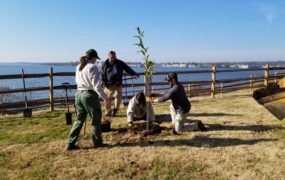

On Friday, May 11th, 2018, the Maryland Urban & Community Forestry Summit was held at the Patuxent Research Refuge National Wildlife Visitor Center. This event brought together urban forestry practitioners from a variety of backgrounds who share a common vision of growing and preserving Maryland’s urban tree canopy. Invited speakers and participants discussed common challenges facing urban foresters, integrating science and management, and engaging communities in urban forestry and stewardship, among other topics.
The Keynote speaker of the event was Dr. Michelle Johnson from the USDA Forest Service, Northern Research Station. Dr. Johnson shared findings from the Stewardship Mapping and Assessment Project (STEW-MAP), a project that uses surveying techniques to map areas and networks of voluntary environmental stewardship organizations in New York City and other cities like Baltimore. Her presentation emphasized the importance of individuals and civic groups in caring for cities’ forests.
Throughout the rest of the day, participants heard from multiple perspectives in the urban forestry field. For instance, Jenny Willoughby (Sustainability Manager, City of Frederick) gave a comprehensive overview of ongoing tree canopy efforts in Frederick, Maryland. Katie Lautar (Program Director at Baltimore Green Space) presented on non-native species management in urban forest patches. Arborist Chris Fallon, with Baltimore Gas & Electric, shared about how a local utility company balances tree canopy retention with the needs of its customers and other safety considerations.
In addition, participants learned about existing opportunities and resources such as the Sustainable Maryland Certification process and Mid-Atlantic Early Detection Network smartphone app. Speakers Mary Kay Malinoski and David Clement, both from the University of Maryland Extension, shared information on how to spot and report emerging tree diseases in Maryland caused by the Spotted Lanternfly and Oak Wilt fungus.

The last session of the Summit included presentations and discussions surrounding environmental justice and community engagement. Sarah Anderson (Founder & CEO of Lillie Leaf Solutions) spoke on environmental justice metrics and the importance of understanding the value people place on their own streets and communities. Tamberly Conway and Serenella Linares talked about how the USDA Forest Service and Audubon Naturalist Society, respectively, are working to reach out to Latino communities and engage minority groups in environmental stewardship.

The Maryland Urban & Community Forestry Summit was organized collaboratively with support from the Maryland Forestry Foundation, the Maryland Department of Natural Resources, the Maryland Urban & Community Forest Committee, the University of Maryland, the Maryland Association of Forest Conservancy District Boards, and Baltimore-Washington Partners for Forest Stewardship. Presentations from the Summit will soon be posted onto the Maryland Forestry Boards website.
Story written by Tuana Phillips





